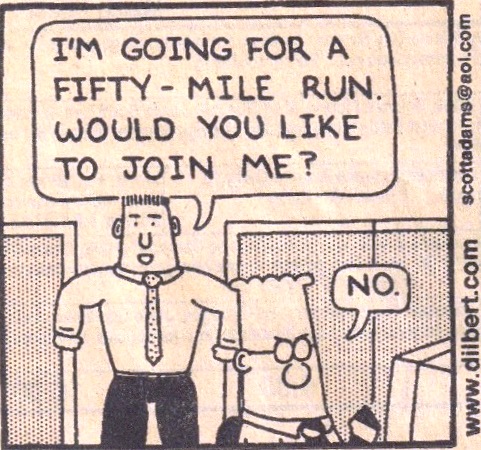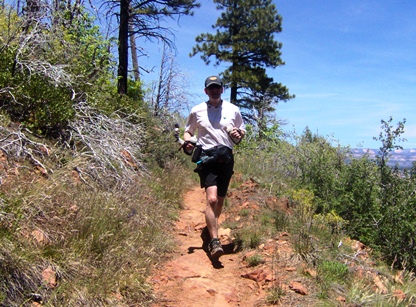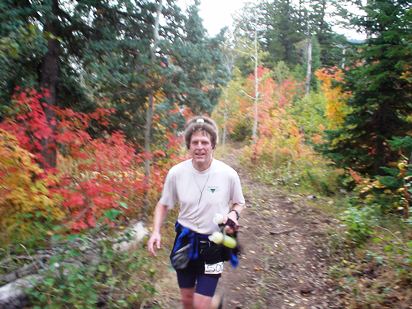
The exciting afterglow feeling of finishing a 100-miler lasted for days. I really did it! For several days I wore sandals to work because my feet were swollen and blistered, but I soon started thinking about what I could run next. I had gained some good confidence and was anxious to race again. Yes, I was really an ultrarunner, but still quite the rookie and making many mistakes. But these mistakes were somewhat overcome with my stubborn determination. I was stumbling through this new sport mostly on my own but soon I would find more help.
For the next few months, I would run and finish four 50-milers. The first would be Old Pueblo 50 near Tucson, my home from 1990-1998. We made it a quick family vacation. Since Rocky Raccoon 100, a month earlier, I had only run 40 miles, trying to heal up from my various aches and pains. I again brought my coonskin hat and many runners who had been at Rocky recognized me.

Old Pueblo 50 is a wonderful desert run in the Santa Rita Mountains. During this race, I met and ran with Matt Watts from Colorado for the first time. This started a friendship that would last through the years. I experienced highs and lows during the race. I was shocked to experience an amazing high point, similar to what I had experienced for a time during Rocky Raccoon 100. At mile 42, I tried to really kick up the pace and was shocked that I could sustain it. On a rolling single-track section I was sprinting along the trail, passing runner after runner. I got great reactions. One runner said he would draft behind me. A minute later I looked back and he was gone, he just couldn’t say with me. It was a great feeling. This was the first ultra that I finished feeling great, full of energy. I finished in 58th place out of 111 starters. I was truly believing that I could be a midpack runner.

Next up was Avalon 50 on Catalina Island in California. I was in town for a business trip but extended it to run on the island. Running at sea level was an amazing feeling. It felt like I was in a oxygen tent. Again, I had sections during the race when I surprised myself and could run very fast. With a few miles to go, I realized that I could actually break 10 hours and beat my 50-mile personal record. I sprinted through the city streets of Avalon and finished in 9:49, in 19th place out of 90 starters.

This was the first time that I truly raced in an ultra. I ran to place well, it worked, and I liked it. How was this possible for a guy who finished dead last in a 50 miler just ten months ago? I was so excited and spent the next hour with other runners cheering the finishers. This was probably the most important race in my ultramarathon history because it greatly boosted my confidence and showed me that I could actually run fast. With more work, what could be possible?

With my confidence high, I guess it was time to run something to bring me down to earth. I went to run Zane Grey 50 in Arizona which is billed to be the toughest 50-miler. I was able to stay with my ultrarunner friend, Todd Holmes at his parents’ house. It was great to further learn from him and feel like a peer now that I was truly an ultrarunner. Zane Grey 50 is so difficult because of the continual climbs and descents on very rocky trails. There are also long stretches of exposed burned areas that become very hot.

For each new race, I would try new things to help. This time I taped a small version of the course elevation profile to my hand-held bottles. I referred to the graph often and it helped me to set my expectation correctly regarding the course ahead. Because of the heat, my coonskin hat lasted only 17 miles. At mile 25 it was very hot. I noticed a guy with some sort of uniform eyeing me. I suspected he was a search and rescue guy wondering if I would be the dude that he would have to haul out of the wilderness. At the 38-mile mark, everything came together. I felt great and was able to really start running again. I pushed through it all and finished in a respectable, 13:55, in 56th place out of 125 starters.
In May 2005, I linked up with a couple other newer local ultrarunners, Jeff Gerke, Wynn Shooter, and Jason Berry. They were all training to run the Bear 100 that year too. Jeff and Wynn had run in my first 50K the year earlier and finished two hours faster than me. But in the past nine months I had progressed to the point where I could now keep up with them.

I joined Jeff and Wynn in a run on the West Rim of Zion National Park (now part of what is called the Zion Traverse). We had a great time. Near the end of the run I had so much energy that I would run ahead to take pictures of the guys descending into the canyon. It was great to be linked up with local runners. But, our problem was that we were just learning from each other. We still lacked an experienced mentor.

A mentor showed up when I offered to pace anyone at Wasatch 100 and Phil Lowry took me up on the offer. Phil was a 100-mile veteran and was going for his 10th Wasatch finish. I hadn’t met him yet, but he gave me much advice in the weeks leading up to that classic race in Utah. He would call me many times and share his experience and offer me advice. I decided that I would pace him for 60 miles, from Big Mountain to the finish. But my confidence was shaken after a DNF at 2005 Leadville 100. I wasn’t prepared for running at that altitude and didn’t make the cutoff on the return to Twin Lakes (mile 60). I told Phil that I thought I should cut back the number of miles I would pace him. He convinced me that I just had a bad day and could handle it.
I met Phil for the first time at the Wasatch 100 race briefing although I realized that I had seen him on the trails before. (Who can miss Phil?). I took in all the nervous excitement coming from the runners and enjoyed meeting many runners who had been reading about my adventures online. Several of my new running friends from Colorado were also there. I decided if all went well during my pacing duties, I would enter Wasatch in 2006. All did go well, very well. I ran with Phil for 60 miles and never had a problem keeping up. For those many hours I observed, learned, and participated in an amazing experience. I noticed that Phil kept a steady pace and steady heart rate. Using a heart monitor he keeps attention to how hard he’s working. As I would follow him for miles, I discovered how much easier it seemed if I kept a steady heart rate pace. As the aid stations arrived, I could run fast ahead and get things ready for him to arrive. In the final miles, I was full of energy. Phil finished in 29:08.

Two weeks later, I was very nervous at the start of Bear 100, my chance to get even for my DNF from the previous year, the site of my first 100-mile attempt. I started the race by simply running behind my new mentor, Phil Lowry. He yelled back to me, “I would have thought that you would be tired of seeing my butt by now.” I kept up with him for the first 15 miles until he kicked it into gear up a tough climb after he had led several of us up a wrong canyon. I hated to see him disappear up and over the ridge because I knew I was now on my own.
My race went well and I was nicely far ahead of my pace from the previous year. But at about mile 50 up on an exposed ridge I experienced the most terrible lightning storm I would ever run in. With fury, the storm blew in and huge flashes of lightning flashed above me. As we came to exposed ridges, with fear in my legs, I did my best to sprint across before the next lightning strike. I ran hunched over, ducking from the lightning. Several times the strikes seemed to be within 100 yards with no delay between the huge flash of light and the loud crack of thunder. I finally arrived at the next aid station where many shaken runners would later quit.
For the second half of the race I learned an important lesson about pacers. Two pacers from work offered to help, both with some good road running experience, but very little trail running experience. I soon learned that if you don’t have the right pacers, they can slow you down. With the weather still poor, I worried about one of my pacers and would slow way down to make sure he was alright as he kept slipping in the mud. Eventually I would just go ahead but then worried and slowed down even more. In the years to come, I would run most of my races without pacers. I would only use those who I trusted and those who would be fine if they couldn’t keep up.
Then disaster struck. At mile 75 I learned that my pacers had driven my van on the wrong road despite my very detailed written instructions. They punctured the van’s oil pan and all the oil had leaked out at the aid station. It was no longer drivable. For the rest of the race I worried. When I worry, I slow down. Unfortunately my pacers offered no solutions for me and were just anxious to get home. As I ran, I called my wife to come rescue me and help me figure out what do to with the van. I continued on, feeling depressed, and crossed the finish line at 32:23 in 29th place out of 62 starters. Phil yelled out that it was Davy Crockett finishing and the cheers went up.
I should have been overjoyed about finishing the Bear 100, a race last year I believed was impossible for me to finish. I collapsed on the lawn, a muddy, tired, painful mass of quivering flesh. It was good to be finished and I was surprised how low my spirits were. My car was broken and my pacer quickly left with no offers to help. Instead of resting, I would have to go get the van towed. My wife arrived several minutes after I finished, and I firmly told her that I was retiring from ultra races. I felt low and unsatisfied by the whole grueling experience. I was done. Over the next couple days at home I packed away all my running things, and told all my friends that I had retired from ultrarunning. I regretted that I had recently subscribed to Ultrarunning Magazine for a year — more wasted money.

However, Phil pulled me out of the funk. A few days later, I went into a meeting at work and there he was. He made a special trip to my workplace to present to me my Bear plaque and buckle. He made a big deal about it and fully embarrassed me in front of my co-workers. On his way out, he smiled at me, and said “Gotcha.” I came back out of retirement. On the next Saturday I was on top of Mount Timpanogos for the 9th time. During that October, I made eight trips to the summit, several with Phil who kept me going and assured me that I was a good ultrarunner.


Great story!! I remember that lightning storm and the mud at the Bear 100 that year.